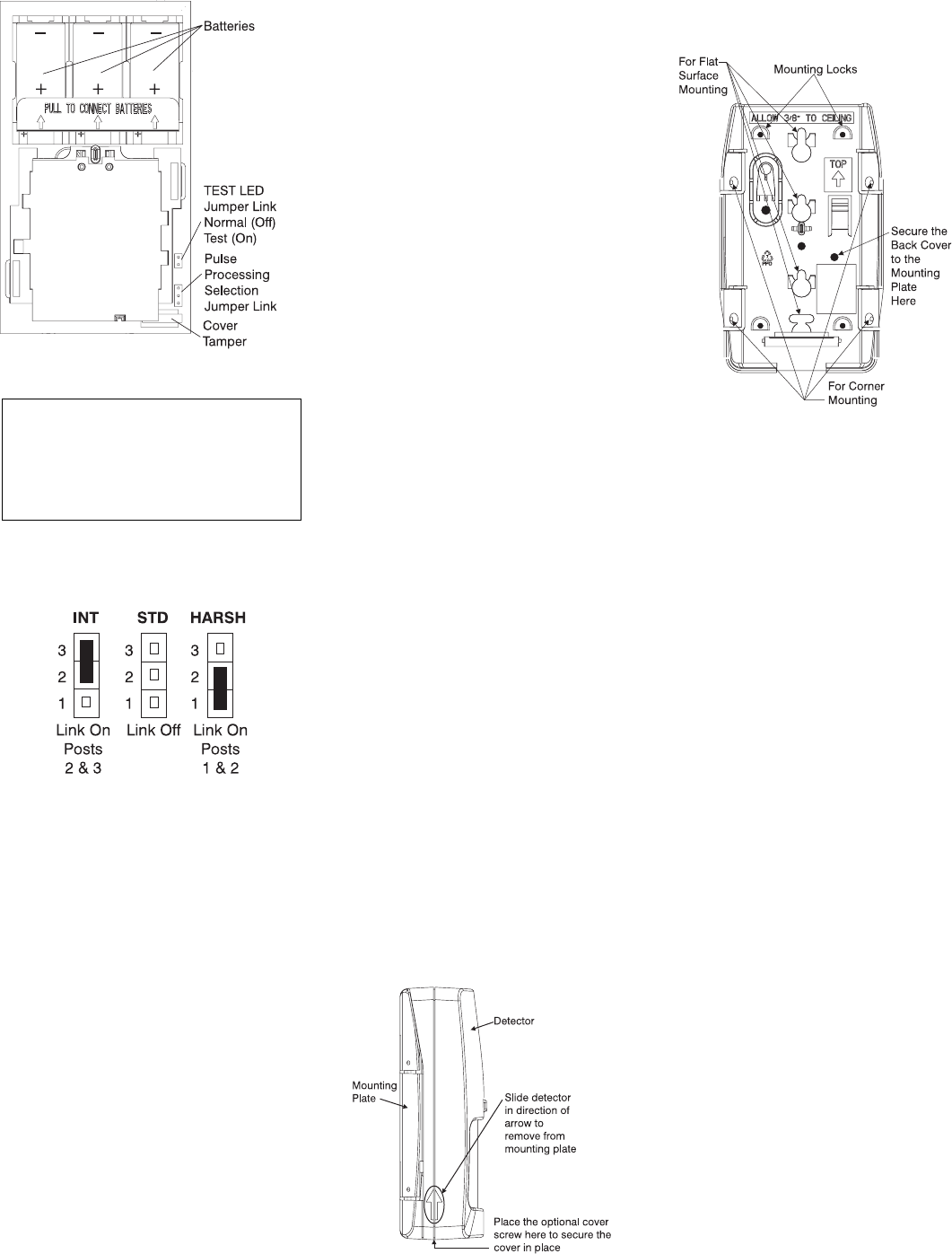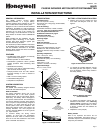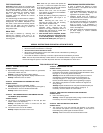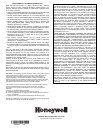
Page 2
Figure 4. Printed Circuit Board (PCB)
Programming Note: If you have not
programmed the detector’s ID into the
system (i.e., this is an initial detector
installation), refer to the
PROGRAMMING
section below and perform the ID enrolling
procedure before mounting or testing the
detector.
PULSE PROCESSING OPTION
See Figure 4 for location of Pulse Processing
selection jumper link.
Figure 5. Pulse Processing Options
Intermediate Pulse Processing (INT) [High
Sensitivity]:
This setting is recommended for
any location where an intruder is expected to
cover only a small portion of the protected area.
The detector tolerates normal environments on
this setting.
Note: INT pulse processing is NOT
recommended for pet immune applications.
Standard Pulse Processing (STD) [Medium
Sensitivity]:
This setting is the recommended
for most applications. The detector tolerates
environmental extremes on this setting.
Note: STD pulse processing is recommended
for pet immune applications.
Harsh Pulse Processing (HARSH) [Low
Sensitivity]:
This setting is recommended for
the severest of environments and should only
be used in locations where an intruder is
expected to cover moderate to large portions of
the protected area.
PROGRAMMING
You must enroll the detector’s ID during
installation of the system. You should
program the 5894PI as an “RF” type unit
(i.e., supervised RF), and the "Loop"
number as "1."
To program the detector, place the LED jumper
in the TEST position (see Figure 4), the Pulse
Count jumper in the STD position (see Figure
5), batteries installed and cover on. Temporarily
cover the lens (a cloth will do) to prevent any
activation by the detector.
When prompted for the device’s serial number,
you may either manually enter it or transmit
from the unit (remove the cloth cover and
motion your hand over the lens to activate the
detector).
Refer to the control panel installation
instructions for programming details.
Remove the LED jumper to disable the LED
(NORMAL position).
INSTALLATION
Installation Hints
•
Do not install where the detector is exposed
to direct sunlight or directly above strong
sources of heat.
•
Make sure the detection area does not have
obstructions (curtains, screens, large pieces
of furniture, plants, etc.) that may block the
pattern of coverage.
•
Avoid locating a unit in areas that contain
objects likely to produce a rapid change in
temperature, such as central heating,
radiators, or ducts (or heaters of any kind),
air conditioners, open flame, etc.
•
Do not mount on an unstable surface.
RADIO TRANSMISSION PATH CHECK
Verify that a strong transmission path between
the 5894PI and the system's Receiver/Control
exists
before permanently mounting the
detector.
Do this by performing the
Walk Test
(described later) with the detector temporarily
mounted in its proposed location. The 5894PI
will transmit when sensing motion (such as a
person waving an arm or walking into an area).
Sometimes, moving the detector only a few
centimeters means the difference between a
strong and weak transmission path. Experiment
until you are satisfied that the location provides
the strongest transmission path, yet is still
practical for the protection pattern desired.
This test also verifies that the detector has
been correctly programmed into the system.
MOUNTING
Mount the unit to a firm vertical surface (flat on
a wall or in a corner).
1. Hold the mounting plate in one hand and
slide the detector in the direction of the
arrows molded on the outside of the plastic
housing.
Figure 6. 5984PI Side View
2. Use the mounting plate to mark the
mounting holes on the mounting surface
(See Figure 7).
Figure 7. Mounting Plate
3. Install the detector mounting plate using the
hardware kit provided.
4. Align the detector base over the mounting
locks on the mounting plate, press the
detector onto the locks and slide down until
firmly locked into position.
Note: For battery replacement or service,
slide the mounted detector in the direction
of the arrows molded into the side of the
detector to dismount the detector.
Note: Mounting Accessories also available:
SMB-10 Swivel Mount Bracket
(P/N 0-000-110-01)
SMB-10T Tampered Swivel Mount Bracket
(P/N 0-000-155-01)
SMB-10C Ceiling Mount Bracket
(P/N 0-000-111-01)
Note: Swivel Mount Brackets should not be
used in pet applications.
LENS MASKING
The masking strips that have been supplied
(Masking Kit P/N K9086) are designed for
application to one or more lens segments to
produce a protection pattern that suits the
particular requirements of the protected area.
Individual masking strips have been provided
for each of the lens segments on the standard
lens supplied with the PIR. Simply peel off the
appropriate pressure-sensitive adhesive strip(s)
and apply over the desired lens segment(s).
Be sure to affix the masking strips to the
inside
of the lens (not the outer, smooth side). Each
lens segment that is masked results in the
elimination of one zone of protection from the
coverage pattern. By masking segments of the
lens, you can adjust the coverage to suit the
area to be protected, or eliminate coverage
from areas where you anticipate environmental
disturbances that might reduce the PIR’s
stability (a heater or other heat-producing
object for example).
Important:
When hallway pattern masking is
used, be sure the PIR is set for instant
response.






